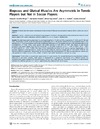Please use this identifier to cite or link to this item:
https://accedacris.ulpgc.es/jspui/handle/10553/6546
| Title: | Iliopsoas and gluteal muscles are asymmetric in tennis players but not in soccer players | Authors: | Sanchis-Moysi, Joaquin Idoate, Fernando Izquierdo, Mikel Calbet, Jose A L Dorado, Cecilia |
UNESCO Clasification: | 241106 Fisiología del ejercicio | Keywords: | Tennis Muscle Asymmetries Injury |
Issue Date: | 2011 | Journal: | PLoS ONE | Abstract: | PURPOSE: To determine the volume and degree of asymmetry of iliopsoas (IL) and gluteal muscles (GL) in tennis and soccer players. METHODS: IL and GL volumes were determined using magnetic resonance imaging (MRI) in male professional tennis (TP) and soccer players (SP), and in non-active control subjects (CG) (n = 8, 15 and 6, respectively). RESULTS: The dominant and non-dominant IL were hypertrophied in TP (24 and 36%, respectively, P<0.05) and SP (32 and 35%, respectively, P<0.05). In TP the asymmetric hypertrophy of IL (13% greater volume in the non-dominant than in the dominant IL, P<0.01) reversed the side-to-side relationship observed in CG (4% greater volume in the dominant than in the contralateral IL, P<0.01), whilst soccer players had similar volumes in both sides (P = 0.87). The degree of side-to-side asymmetry decreased linearly from the first lumbar disc to the pubic symphysis in TP (r = -0.97, P<0.001), SP (r = -0.85, P<0.01) and CG (r = -0.76, P<0.05). The slope of the relationship was lower in SP due to a greater hypertrophy of the proximal segments of the dominant IL. Soccer and CG had similar GL volumes in both sides (P = 0.11 and P = 0.19, for the dominant and contralateral GL, respectively). GL was asymmetrically hypertrophied in TP. The non-dominant GL volume was 20% greater in TP than in CG (P<0.05), whilst TP and CG had similar dominant GL volumes (P = 0.14). CONCLUSIONS: Tennis elicits an asymmetric hypertrophy of IL and reverses the normal dominant-to-non-dominant balance observed in non-active controls, while soccer is associated to a symmetric hypertrophy of IL. Gluteal muscles are asymmetrically hypertrophied in TP, while SP display a similar size to that observed in controls. It remains to be determined whether the different patterns of IL and GL hypertrophy may influence the risk of injury. | URI: | https://accedacris.ulpgc.es/handle/10553/6546 | ISSN: | 1932-6203 | DOI: | 10.1371/journal.pone.0022858 | Source: | PLoS ONE [ISSN 1932-6203], v. 6 (7), (e22858) |
| Appears in Collections: | Artículos |
Show full item record
This item is licensed under a Creative Commons License

